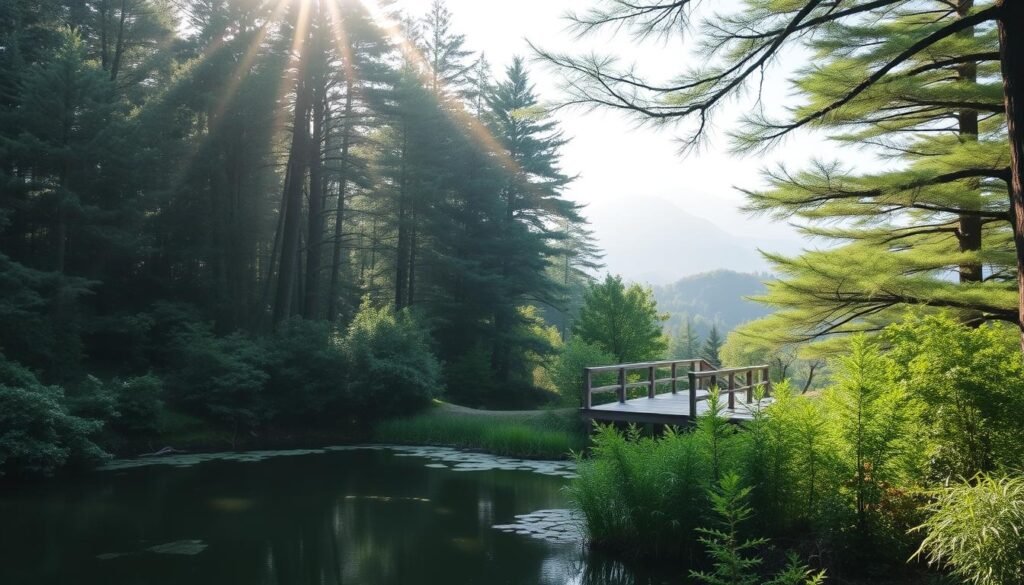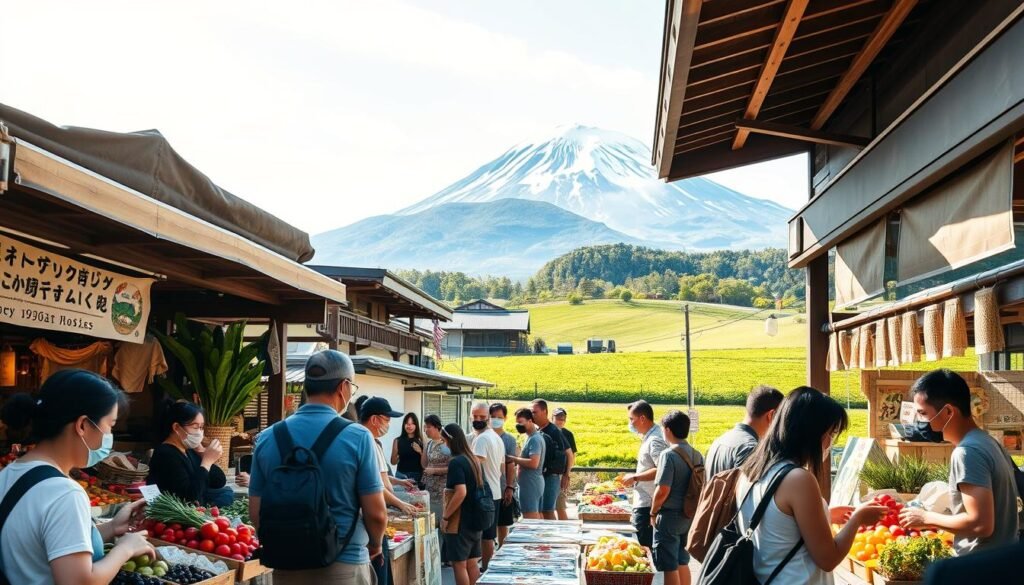Start your adventure in Japan, where old traditions meet sustainability. The country’s mountains and forests are home to many ecotourism activities.
This sustainable travel guide will show you the best ways to travel in Japan. You’ll learn how to enjoy nature while keeping it safe for future visitors.
Key Takeaways
- Discover eco-friendly accommodations in Japan
- Explore Japan’s efficient public transport system
- Experience nature-friendly adventures in Japan’s lush green spaces
- Learn about sustainable travel practices in Japan
- Enjoy Japan’s diverse ecotourism experiences
Understanding Ecotourism in Japan
Japan’s ecotourism is based on living in harmony with nature. This idea is seen in Satoyama and Satoumi. These concepts focus on using natural resources wisely.
The Philosophy of Satoyama and Satoumi
Satoyama is the area between mountains and villages, where humans and nature live together. Satoumi is the coastal area where people and the sea are balanced with conservation. These ideas are key to Japan’s ecotourism.
Japan’s Unique Approach to Environmental Conservation
Japan is dedicated to protecting the environment. It has many national parks and protected areas. This makes it perfect for responsible tourism. Visitors can enjoy these places while helping local communities and conservation.
The Growth of Green Tourism in Japan
Green tourism in Japan is growing fast. Many tours are now eco-friendly, like hiking and bird-watching. People can also help with local conservation projects. So, green tourism destinations in Japan are getting more popular.
Learning about Japan’s ecotourism helps travelers. They can have enriching experiences that also help nature and local communities.
Top Ecotourism Destinations in Japan
Japan is full of ecotourism spots, perfect for all kinds of travelers. You can find everything from untouched wilderness to UNESCO World Heritage Sites. Each place is as beautiful as it is unique.
Hokkaido’s Pristine Wilderness
Hokkaido, Japan’s northern island, is known for its untouched beauty. Outdoor enthusiasts can hike, camp, and watch wildlife in its national parks. Shiretoko National Park, a UNESCO site, is a must-see.
The island also focuses on sustainable tourism. This means visitors can enjoy its beauty while helping protect it.
Yakushima Island: A UNESCO World Heritage Site
Yakushima Island, near Kyushu, is a paradise for nature fans. Its ancient forests, called “Yakusugi,” are full of life. It’s great for eco-friendly trekking and exploring.
The island is dedicated to sustainable tourism. It works hard to keep its ecosystem balanced, giving visitors a deep ecotourism experience.
The Iriomote Island Experience
Iriomote Island, in Okinawa Prefecture, is famous for its mangrove forests and wildlife. You can see the rare Iriomote wildcat on guided eco-tours. These tours help protect the island and support the community.
The island is also great for snorkeling, kayaking, and seeing marine life. It offers a special island experience.
Nikko National Park
Nikko National Park, in Tochigi Prefecture, is known for its temples and natural beauty. It’s a mix of cultural heritage and ecotourism. Visitors can see historic sites and enjoy the scenery.
Nikko has many activities, like hiking and forest bathing. These activities let you connect with nature while respecting the area’s culture and environment.
Seasonal Considerations for Eco-Friendly Travel
Japan’s seasons offer a unique experience for eco-conscious travelers. From cherry blossoms in spring to snow in winter, each season has its own charm. They provide opportunities for eco-conscious activities and sustainable travel.
Spring: Cherry Blossoms and Mountain Trails
Spring in Japan is a time of renewal. Cherry blossoms bloom across the country. It’s perfect for hiking in the mountains, surrounded by beautiful flora.
Popular spots include the Japanese Alps and Kyoto’s cherry blossom paths.
Summer: Coastal Ecosystems and Marine Life
Summer brings warm weather, ideal for exploring Japan’s coastlines. Visitors can snorkel, dive, or relax on beaches in Okinawa or Hokkaido. It’s also a great time for marine conservation activities.
Autumn: Forest Bathing Among Fall Colors
Autumn in Japan is famous for its vibrant fall colors. It’s perfect for forest bathing (Shinrin-Yoku). Nikko National Park and Hokkaido’s mountains offer serene experiences.
Winter: Sustainable Snow Tourism
Winter turns Japan into a snowy wonderland. It’s great for sustainable snow tourism. Skiing, snowshoeing, and hot spring visits are popular.
Resorts like Niseko in Hokkaido and the Japanese Alps offer eco-friendly options.
| Season | Eco-Friendly Activities | Popular Destinations |
|---|---|---|
| Spring | Hiking, Cherry Blossom Viewing | Japanese Alps, Kyoto |
| Summer | Snorkeling, Diving, Marine Conservation | Okinawa, Hokkaido |
| Autumn | Forest Bathing, Hiking | Nikko National Park, Hokkaido |
| Winter | Skiing, Snowshoeing, Hot Springs | Niseko, Japanese Alps |
Planning your trip by season can enhance your sustainable travel in Japan. Whether you love nature, culture, or adventure, Japan’s seasons have something for every eco-conscious traveler.
Sustainable Transportation Options in Japan
Japan’s transportation network is a model for sustainable travel. It offers many eco-friendly options for visitors. The country is committed to reducing its carbon footprint through efficient systems.
Navigating Japan’s Efficient Rail System
Japan’s rail network is known for its punctuality and efficiency. It’s a great way to travel across the country. The famous Shinkansen bullet trains are fast and environmentally friendly.
Visitors can buy a Japan Rail Pass. It allows unlimited travel on JR trains, buses, and ferries. This makes travel convenient and reduces the need for multiple tickets.
Electric Bike Rentals and Cycling Routes
For a more relaxed pace, electric bike rentals are available in many cities. They let visitors explore local areas without harming the environment. Japan has many cycling routes, like the Shimanami Kaido, a 70km route connecting Honshu to Shikoku.
This route offers scenic views and a chance to see rural Japan.
Low-Impact Local Transportation
Japan also offers buses and community-driven car-sharing services. These are low-impact local transportation options. Many cities have pedestrian-friendly paths, making walking a good option for short distances.
Carbon Offsetting Your Travel
Travelers can reduce their carbon footprint by carbon offsetting. Many airlines and travel companies offer carbon offset programs. These programs let visitors compensate for their emissions by supporting environmental projects.
By using Japan’s sustainable transportation options, visitors can reduce their environmental impact. They can enjoy the country’s culture and natural beauty. Traveling in Japan can be convenient and eco-friendly, showing the principles of responsible tourism japan and eco-friendly travel japan.
Eco-Friendly Accommodations
Japan offers many eco-friendly places to stay for those who want to travel green. These spots mix tradition with care for the planet. They meet different needs and tastes.
Traditional Minshuku and Ryokan with Green Practices
Japanese inns, or ryokan, and family-run minshuku are key to Japan’s hospitality. They now use green methods to lessen their impact. They build with local materials and save energy.
Eco-friendly initiatives include natural hot springs and organic food. They also reduce waste. Guests get a deep cultural dive while helping the planet.
Eco-Lodges and Sustainable Resorts
Japan also has eco-lodges and resorts for a modern green stay. They use green tech and sustainable materials. These places are in beautiful spots.
Guests can enjoy nature walks and bird watching. It’s a peaceful way to connect with nature.
Farm Stays and Agricultural Tourism
Farm stays, or “gaijyo,” let you see rural life up close. They support local farms and teach about sustainable farming. It’s a unique cultural experience.
Guests can help with farm work and eat meals made from fresh local food. It’s a way to appreciate the land and its people.
Certification Systems for Green Accommodations
Japan has systems to help travelers choose green places to stay. These programs check hotels and inns for their green efforts. They look at energy use and commitment to the environment.
Choosing certified places means you’re supporting true eco-friendly spots. It makes your trip better and helps Japan’s nature stay beautiful for others.
Nature-Friendly Adventures and Activities
Japan’s natural beauty is stunning, from calm forests to lively marine life. The country offers many activities that let visitors connect with nature. These activities also help support sustainable tourism.
Forest Bathing (Shinrin-Yoku)
Forest bathing, or Shinrin-Yoku, is a traditional Japanese practice. It involves spending time in the forest to improve health. This activity helps visitors feel more connected to nature and can lower stress and boost mood.

Wildlife Watching: Ethical Practices
Japan is full of wildlife, like deer and rare birds. Watching wildlife ethically is key to protect their homes. Visitors can join guided tours that follow rules to help the environment. This way, they can enjoy the experience while supporting conservation.
Sustainable Hiking and Trekking
Japan has many places to hike and trek, from Hokkaido’s mountains to Okinawa’s islands. It’s important to hike sustainably, like staying on trails and not littering. Many trails offer amazing views and a chance to see Japan’s unique plants and animals.
Marine Conservation Activities
Japan’s seas are full of life, perfect for snorkeling, diving, and marine conservation. These activities are not just fun but also help protect marine life. Visitors can help preserve Japan’s underwater world through these activities.
| Activity | Location | Best Time |
|---|---|---|
| Forest Bathing | Nikko National Park | Spring and Autumn |
| Wildlife Watching | Hokkaido | Summer |
| Sustainable Hiking | Nakasendo Trail | Spring and Autumn |
| Marine Conservation | Okinawa | Summer |
Trying these nature-friendly adventures makes your trip better. It also helps protect Japan’s beauty for the future.
Cultural Immersion Through Sustainable Practices
Travelers can dive into Japan’s culture while helping the environment. This way of exploring enriches the journey and helps local communities. It also keeps traditional ways alive.
Traditional Crafts and Sustainable Materials
Japan is famous for its crafts made from eco-friendly materials. Visitors can join workshops to make washi paper, ceramics, and woodblock prints. These activities help keep cultural traditions alive and support local artists.
Some notable traditional crafts include:
- Washi Paper Making: This craft uses mulberry tree bark, passed down through generations.
- Handmade Ceramics: Artisans make pottery from natural clays and glazes, often in traditional kilns.
- Woodblock Printing: This ancient method carves designs into wood blocks for printing on paper or fabric.
Participating in Local Conservation Efforts
Travelers can join in on conservation projects like forest restoration and marine cleanups. These efforts help the environment and teach about Japan’s natural world.
Examples of conservation efforts include:
- Forest Bathing Initiatives: Guided tours that help connect with nature and improve forest health.
- Marine Conservation: Programs clean up coastlines and monitor marine life.
- Wildlife Protection: Projects protect endangered species and their habitats.
Eco-Friendly Festivals and Events
Japan’s festivals celebrate the seasons and its culture. Many now focus on being eco-friendly, like reducing waste and using sustainable decorations.
Some notable eco-friendly festivals include:
- Cherry Blossom Festivals: Many now aim to reduce waste and promote sustainable viewing.
- Star Festivals (Tanabata): Celebrated with lanterns from recycled materials and minimal waste.
Learning from Japan’s Traditional Environmental Wisdom
Japan values living in harmony with nature, shown in “Satoyama” and “Satoumi.” Visitors can learn about these through workshops and tours. This way, they gain insights into sustainable living and help preserve Japan’s heritage.
Responsible Food Tourism in Japan
Responsible food tourism in Japan means enjoying local food while helping the environment. Japan’s food is famous worldwide. By choosing wisely, travelers can enjoy their meals and help protect Japan’s nature.

Farm-to-Table Experiences
Farm-to-table experiences are a big part of Japan’s food tourism. They let travelers eat fresh, local food and support farmers. In rural Japan, visitors can learn about farming and taste the difference.
Sustainable Seafood Choices
Japan is known for its seafood. Choosing sustainable seafood is key for the ocean. Travelers can pick seafood with the Marine Stewardship Council (MSC) label. This helps the sea and supports local fishermen.
Reducing Food Waste: The Mottainai Concept
The “Mottainai” idea is big in Japan. It’s about not wasting food. Travelers can help by picking places that waste less and using local ingredients.
Vegetarian and Vegan Options for Eco-Conscious Travelers
Japan has lots of vegetarian and vegan food for those who care about the planet. Shojin-ryori, a Buddhist diet, is all plant-based. Many restaurants now have vegan dishes, making it easy for everyone to enjoy Japan’s food.
| Aspect | Description | Benefits |
|---|---|---|
| Farm-to-Table | Experiencing local produce and farming practices | Supports local farmers, fresh produce |
| Sustainable Seafood | Choosing MSC-certified seafood | Marine conservation, supports local fishing communities |
| Mottainai | Reducing food waste | Cultural immersion, reduces environmental impact |
| Vegetarian/Vegan | Exploring plant-based Japanese cuisine | Eco-friendly, diverse culinary experience |
By following these tips, travelers can have a better, greener food experience in Japan. Whether it’s through farm-to-table, choosing sustainable seafood, or reducing waste, every choice helps.
Planning Your Ecotourism Trip to Japan
Planning an ecotourism trip to Japan needs careful thought. It’s important to plan well to enjoy Japan’s beautiful landscapes and culture. You’ll also want to explore Japan’s eco-friendly efforts.
Pre-Trip Preparation and Packing Tips
Before you go to Japan, get ready the right way. Pack light and choose items that are good for the planet. Bring reusable items like water bottles and bags. Knowing the weather and local customs will make your trip better.
Eco-friendly packing tips:
- Use reusable bags and containers
- Choose clothing made from sustainable materials
- Bring a refillable water bottle
Eco-Friendly Tour Operators and Guides
Choosing the right tour operator is key. Look for ones that are eco-friendly and have local guides. Guides can share a lot about Japan’s nature and culture. This makes your trip more meaningful.
Language and Cultural Considerations
Even though many Japanese speak some English, learning Japanese can help a lot. Knowing cultural rules, like how to act in temples, is also important. It makes your trip better and shows respect for Japan.
Budgeting for Sustainable Travel
Planning your budget for travel is more than just money. It’s about making choices that help the planet. Stay in eco-friendly places, use public transport, and support local businesses. This way, your trip is good for you and the environment.
Tips for sustainable budgeting:
- Choose eco-friendly accommodations
- Use public transportation or cycle
- Support local, sustainable businesses
Conclusion: Embracing Japan’s Harmony with Nature
Japan’s deep connection with nature is a big reason to visit. Our choices affect the environment and local people. By choosing sustainable travel, we help keep Japan’s beauty and culture alive.
Visiting Japan’s green spots, like Hokkaido and Yakushima Island, lets us connect with nature. Making smart choices enriches our journey and benefits others. Japan’s approach to tourism is a great example of how to care for the planet and grow economically.
















Leave a Reply